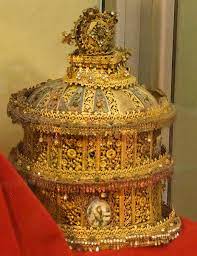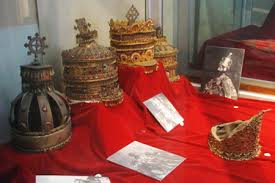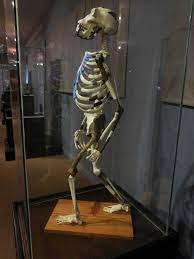Introduction
The museums provide a way of having an evaluation and analysis that enhance making discoveries in the environment are set to collect artifacts and archeological findings. Contextually, the museum for discussion is the National Museum of Ethiopia, located in Egypt. It houses a broad collection of items that span from ancient Ethiopian times. It is home to significant monumental structures that greatly reflects Ethiopian development over the large span of historic transition. Artifacts of many kinds reflect this, and its sign shows the architectural designs characteristic of the Ethiopian culture. It has different departments assigned other roles in preserving artifacts and cultural pieces at the museum.



Main body
The museum displays a wide range of artifacts and ancient exhibits, notably the Ethiopian Crown worn by Menelik II as the Emperor of Ethiopia. It is an excellent depiction of the cultural structures and organization among the people of Nigeria, which held firm views regarding onarchy as a form of leadership structure. It acts as a reminiscence of the achievements of Menelik in the fight against an alien civilization. It creates a connection due to the narrative supplied by the ancient presence asserting of descendant from David and Sheba. The Crown is found inside the stadium as a distant remembrance of the efforts of the Emperor, which led to the expansion of Ethiopian territories, recognition, and formation of a more robust government. Also, the museums host artifacts representing archaeological discoveries. It helps to represent the views of the Ethiopian cultures and the change in the need to recognize the transition of life through evolutionary stages. Its wide range of artifacts and exhibits depicts the rich and broad concept of the Ethiopian culture (Huber 98). The artifacts are placed as exhibits for the show to interested individuals and foreigners.
The artist of the Crown is Emperor II, a leader between 1889 and 1913 in his demise. He led to a significant transformation of Ethiopia’s cultural and political aspects by leading expedition missions and warfare against foreign investors. He actively engaged in efforts to expand Ethiopian territories and implement an inclusive leadership style based on diplomacy. He championed for centralization implementation to rid Ethiopia of the wars and setbacks that had ravaged the country. He pushed for the abolition of slavery and trade affairs, improved enhanced progressions in technological advancements (Mekuria et al. 64). More notably, he was involved in warfare to pursue the interests of interest to Ethiopia and its passage.
The style used to portray the Crown, which the Emperor wore, is made of a metal which pictures and writings improve how people understood the needs and what it means concerning leadership contexts of the people of Ethiopia. The media style is interactive and gets to paint a grim of the leadership in ancient Ethiopia. The exhibit is used in the scope of installation artists. It is used as a piece for communicating the aspects relating to the artifact exhibit in its most original first-hand form. What stands out to be peculiar in the exhibit’s design is the presence of spaces between the outlines of its creation.
Several exhibits are displayed in the specific museum environment to reflect on the Ethiopian people’s prosperous cultural organization. They are placed at the museum points to enable ease of access to help tourists understand the ancient people’s cultural needs and behaviors and the progression. The exhibit of Crown is in the form of a human head as it was on the head by the Emperor as a sign of leadership. It is lined with golden to show how respected and royal the Emperor was. It shows the divine power of leadership. The Crown has a texture of many shapes, which is also a depiction of the diversity of the Ethiopian culture. Interacting with the museum at the museum environment brings a feeling of joy and pride, in reminiscence of the achievement of the Emperor in serving the country.
The presence of archaeological artifacts as an exhibit creates the impression of Ethiopia having a more profound and richer connection with the concept of the development and evolution of humankind. The Discovery of Lucy shows the respect and the attitude towards the context of the evidence of the presence of life in ancient times and its evolution. It allows for studies and reviews that seek to understand the human origin while also giving a dimension of a broad collection to the museum and building high standards.
The artifact, Crown of Menelik II of Ethiopia, has a beautiful and elegant design structure, articulating drawings with the blend of color to show how deep-lying and adaptive the Ethiopian culture was in terms of artistic designs. Its shape is also typical of the art of Ethiopian culture. What is distinct about the exhibits is the attitude and attention accorded at the museum houses. The Crown and Lucy as shows attract large viewership and proposes techniques for leading to a more robust approach towards handling the same.
In both exhibits of the Crown and the archeology of Lucy, the display methods are the same where they are placed in the museum rooms for viewership. On the other side, Lucy is made of bones and human remains, while the Crown is a metal structure made for use by the king. Also, Lucy is used to depicting perception into the issue of evolution, while the Crown evaluates the leadership in the ancient Ethiopian culture.
Bauhaus is an artistic technique, which originated in Germany, asserting the need for construction and related technique aspects to show values and aspects on cultural and social trends (Cowcher 1173). It is used in depicting the Crown to reflect on the lifestyle in the Ethiopian culture. The beautiful design patterns show how the story of art is regarded in Ethiopia. Different aspects shown on the design of the Crown represent the various cultural shapes and diversity which exists among the people of Ethiopia.
The issue concept of exhibitions at the museum has controversies that seek to point out the shortcomings in the museum industry. Display Lucy as a skeletal structure to enhance relation towards understanding the evolution and progressive development is unethical. It undermines the beliefs held by certain civilizations which advocate for respect for death. The display of the Crown is also a way of reminding the people of the suppressions and the sufferings of foreign forces. It leads to a mentality perspective, which ideologies against the perpetrators of the mistreatment actions. It depicts disrespect towards the death, and in a way that breeds perception of the humans and the end in a negative aspect.
The Crown is placed in a spacious room on a red carpet. The space hosts other artifacts, mainly of the same form, and it shows how the artifacts were important integration into the cultural and social lives of the Ethiopian people. It is paced carefully, bounded by the glass in the room structure to ease accessibility. The archaeology of Lucy is placed in a room and supported by systems to maintain the shape of a human skeleton. The artifact is placed in a well-paced room to allow for comfort of access by probable viewers. The placement for each considers many effects that affect the needs interests of those who wish to use the artifacts.
The spacious provisions work a great way in enhancing the artists in their expressions. It gives more freedom to the viewer to gain a more elaborate and deep perception of the integration of museum exhibitions and their significance (Gnisci 52). Its provisions for a setup environment for flexible changes to the planning and organization of the museum outlay in the different rooms. In placing the exhibits, the relative relationship of each forms a comfortable position for viewing, as it takes into account the average height. On the contrary, to improve the exhibit setting at the museums, the use of less conspicuous colors of clothing would enhance attention and concentration. With the archeological artifact of Lucy, the room in which it is placed should have light modifications to adopt more ambient brightness, which is safe for the eyes. The use of bigger print pictures to display more angles items at the museum enhances clearer viewership. The exhibits should be placed with clear labels and explanations of description and illustrations to give a seamless approach and ease of understanding.
Summary
To sum up, the crown exhibit in the National Ethiopian Museum is an excellent show of the importance of preserving ancient artifacts to communicate the lifestyles and issues prevalent with a culture. Museums are places where the problems and contexts of the current can get to intertwine with the past, creating a blend that leads to understanding the progress and transition perspectives in a new dimension. The collection of artifacts forms a solid basis for learning processes and institutional provisions due to references. It includes a rationale for relating the current events and the past and concluding to make inferences about human existence. Students also use them to do research and studies revolving around the evidence pieces found in the museum.
Works Cited
Cowcher, Kate. “The museum as a prison and other protective measures in socialist Ethiopia.” International Journal of Heritage Studies 26.12 (2020): 1166-1184.
Gnisci, Jacopo. “Crosses from Ethiopia at the Dallas Museum of Art: An Overview.” African arts 51.4 (2018): 48-55.
Huber, Marie. “Building up Ethiopian heritage institutions.” Developing Heritage–Developing Countries. De Gruyter Oldenbourg, 2020. 94-118.
Mekuria, Merkeb, and Raymond Silverman. “National identities and the National Museum of Ethiopia.” National Museums in Africa. Routledge, 2021. 56-72.